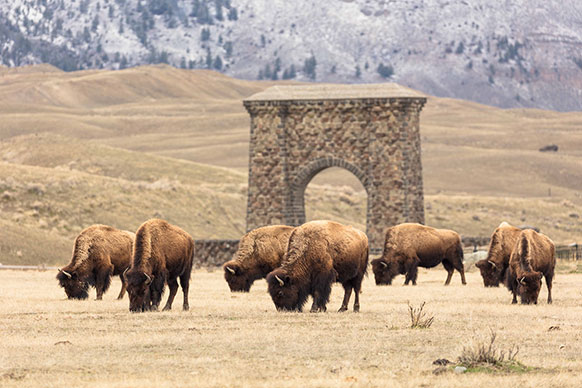UW, Other Researchers Find Benefits from Bison Grazing, Movement in Yellowstone
Published August 28, 2025

Bison graze near the Roosevelt Arch in Yellowstone National Park. New research involving a UW scientist shows that, as bison move across the landscape, they amplify the nutritional quality and capacity of Yellowstone. (Jacob Frank/National Park Service Photo)
Scientists from the University of Wyoming, Washington and Lee University and the National Park Service have published research shedding new light on the value of bison recovery efforts in Yellowstone National Park.
While momentum in some circles is building to restore bison across North America, most efforts focus on small, managed herds, leaving it unclear how large, migrating herds shape landscapes and whether their effects enhance or degrade ecosystems. The study by UW’s Jerod Merkle, Chris Geremia of the National Park Service and Bill Hamilton of Washington and Lee University evaluated large migrating herds of bison in Yellowstone, observing their grazing habits as they concentrate in the park’s river valleys during spring and summer.
The researchers found that, as bison graze, they speed up the nitrogen cycle, resulting in more nitrogen available for plants to use and, ultimately, more nutritious plants for plant-eating animals. The findings appear today (Thursday) in Science, one of the world’s top academic journals.
With a population of around 5,000 animals -- stabilized since the mid-2010s, after recovering from a low of just 23 animals in 1902 -- Yellowstone bison today travel about 1,000 miles each year, making back-and-forth movements along a 50-mile migration route. Along their route, the bison graze intensely, consuming young, growing plants emerging after snow melts. To many, this might look overgrazed, but the researchers found that it is far from the whole story.
The team’s study suggests that, as a result of bison speeding up the nitrogen cycle as they graze, the plants grow as much as they would if they weren’t grazed -- and, strikingly, are 150 percent more nutritious.
The nitrogen cycle is how nitrogen moves among the plants and animals of the ecosystem and the air and soil. Microbes in the soil recycle nitrogen from decaying plants and animals into forms typically seen in common fertilizers. Those forms, such as ammonium and nitrate, are favored by plants to reuse.
The researchers found that bison grazing increases the volume of microbes. And, as the grazing continues throughout the summer, this cycle is reinforced, keeping plants short, dense and nitrogen rich.
“What we’re witnessing is that, as bison move across the landscape, they amplify the nutritional quality and capacity of Yellowstone,” Hamilton says. “Their grazing likely has important consequences for other herbivores and for the food web as a whole, similar to the changes that occurred in the Serengeti when the wildebeest population recovered.”
To understand how bison create these changes in the nitrogen cycle, the researchers conducted field experiments from 2015 to 2021, monitoring plant growth, nutrient cycling, plant and soil chemistry, herbivory, plant community composition and soil microbial populations. They used movable exclosures to compare grazed and ungrazed conditions, and they combined these experiments with landscape-scale satellite imagery and GPS collar data. This allowed them to map bison impacts across the entire migratory landscape.
Over the course of the study, the researchers found that the soils sustained their nutrient storage. Plant communities changed in some areas, but productivity was maintained, and the biodiversity of plants increased across the migration corridor.
Overgrazing is often characterized as a landscape where plant productivity and diversity go down and soils become compacted, with resulting reductions in nutrient storage and cycling.
“Yet, we found pretty much the opposite of that,” Merkle says. “The return of a large-scale bison migration provides clear benefits to the ecosystem services that underlie Yellowstone. Heterogeneity is what bison seem to provide. When I look out across the bison migration, there is strong variation in the amount of grazing -- some places appear to be very short lawns while others remain untouched.”
Yellowstone has long served as a model of ecological restoration, and this new research highlights the overlooked power of restoring large herbivores in large, free-moving numbers, the researchers say. Unlike traditional bison conservation efforts focused on small, fenced areas and controlled numbers based on grazing management principles, Yellowstone shows the value of restoring movement and scale. Migrating bison reshape the land not by being managed, but rather by moving.
“With the current large herds of bison, Yellowstone grasslands are functioning better than in their absence,” Hamilton says. “And this version is a glimpse of what was lost when bison were nearly wiped out across North America in the late 1800s.”

